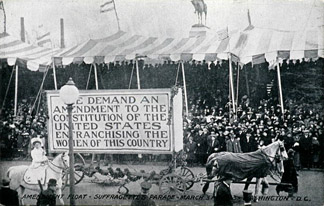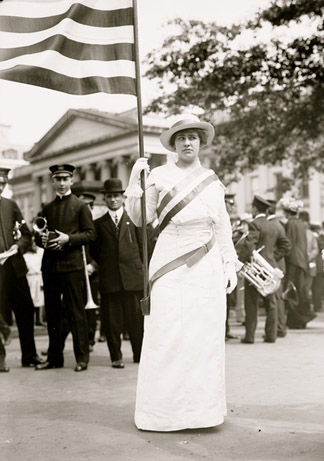Published 20/05/2016
To commemorate Women's History Month, we've put together a short history of the National Women's Party, one of the most influential women's rights organizations of the 20th century.
|
Origins of the Suffrage Movement Many of the early suffragists came to the movement though the abolitionist cause of the late 19th century. In fact, one of the first organizations to take up the cause did so while also fighting for equal rights for African Americans, the American Equal Rights Association (AERA). Founded by Lucy Stone and Susan B. Anthony in 1866, this organization eventually splintered off into two groups, the more federal-focused National Woman Suffrage Association (NWSA) and the American Woman Suffrage Association (AWSA), which fought more for rights at the local level. In 1890, the two groups again came together as one organization forming the National American Woman Suffrage Association (NAWSA) with the sole purpose of gaining the women's vote. Elizabeth Cady Stanton and Susan B. Anthony would lead the organization through the end of the century, with Carrie Chapman Catt succeeding them in 1900. |

|

|
NAWSA & National Women's Party In the first decade of the 20th century, Alice Paul and Lucy Burns became interested in women's right to vote while studying in England. They met and worked with militant advocates Emmeline Pankhurst and her two daughters Christabel and Sylvia. Witnessing first hand and participating in the Pankhursts' more aggressive tactics made an impression on the two, who felt that more aggressive means may be the only way to gain enfranchisement for women in the States. Paul and Burns returned home with an energized sense of urgency for their cause and the desire to lobby the NAWSA to switch their focus from states rights to a federal constitutional amendment and to pursue more militant tactics in order to achieve the end. |

|
After joining the NAWSA, Paul and Burns headed up the group's congressional committee. They eventually broke from the larger NAWSA organization over disputed tactics, to become the Congressional Union. This later formed the National Women's Party. One of their first organized events was a massive suffrage pageant on Pennsylvania Avenue on March 3, 1913, the day before Woodrow Wilson's inauguration. The parade included almost 5,000 marchers, 24 floats, nine bands and four mounted brigades. The scene turned ugly when male onlookers attacked and jeered the suffragists, but the publicity from this event helped to propel the movement into the national discourse. The tactics employed by the NWP included picketing in front of the White House, elaborate marches and demonstrations, long distance suffrage hikes, automobile tours and hunger strikes. |

|

|
|
19th Amendment & Beyond The decades of work put in by the various suffrage organizations finally resulted in the 19th Amendment to the U.S. Constitution, legalizing voting rights for women, on August 18, 1920. The NWP's efforts didn't stop there though. In the 20s, Alice Paul's Equal Rights Amendment (ERA) and more than 600 pieces of legislation for things such as divorce, custody and property rights, jury service, and contractual and marriage rights were introduced. Paul also launched "Women for Congress" campaigns in 1924 and 1926. Once voting rights were established in the U.S. the organzation turned their focus to helping women internationally. In the 30s, the Equal Nationality Treaty was proposed to eliminate discrimination across the globe, and the the World Women's Party was created to assist Jewish women in escaping Europe. In addition, the NWP has a legacy as part of the 2nd wave feminism movement which saw the passing of the Equal Pay Act of 1963 and also the Civil Rights Act of 1964 which barred discrimination based on color, race or national origin, in addition to sex. After its introduction in the 20s, ERA was passed but later failed in the 1970s after several states failed to ratify the amendment within the specified time limit. In the mid-90s, the NWP ceased its lobbying activities and focused more on education, continuing today as a museum and an organization devoted to preservation. |

|


